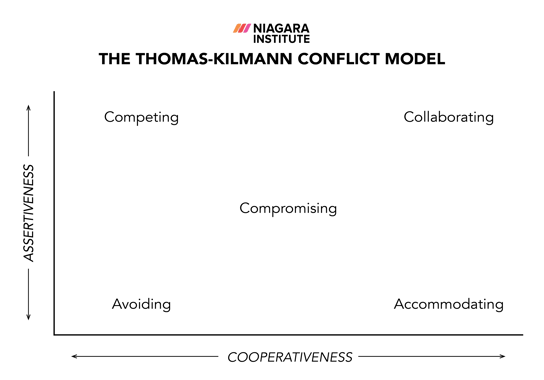2 min read
Conflict Styles Quiz: What's Your Approach to Conflict?
No one likes conflict, especially at work. But disagreements between those you work with are sometimes inevitable. So, the question isn’t how you...
6 min read
 Michelle Bennett
:
May 3, 2022 6:00:00 AM
Michelle Bennett
:
May 3, 2022 6:00:00 AM

Workplace conflict is bound to happen. When individuals are passionate and committed to their accountability for results, differing opinions will arise on decisions, resource allocation, and direction.
You can’t (and shouldn’t) eliminate conflict, as disagreements can have a positive impact. One study found that workplace conflict led to better solutions to problems, significant innovations, increased motivation, a better understanding of others, and higher team performance.
However, harnessing the positive outcomes of conflict and avoiding the pitfalls of hurt feelings, emotional stress, and non-cooperation comes down to self-awareness of your natural tendency to use specific conflict handling styles. Recognizing and adapting your approach can lead to more constructive and effective conflict resolution.
Using smoothing conflict resolution techniques can help address conflicts gently and maintain harmony. To take it one step further, understanding the conflict management styles of your peers and employees ensures you respond in the best way, which leads to growth, not work disruptions. You can learn your style and have your peers do the same by completing our Conflict Management Styles Quiz.
Conflict management styles categorize the different ways individuals approach and respond to conflict at work. Conflict styles were developed in the 1970s by two psychologists, Kenneth Thomas and Ralph Kilmann. Thomas-Kilmann Model suggests five conflict styles are methods people use to handle disagreements. These conflict styles help explain how different individuals approach conflicts.
Thomas and Kilmann's five conflict styles include collaborating, competing, compromising, accommodating, and avoiding.
Each style has unique strengths and weaknesses, and understanding them can help people handle conflicts better.

Each of the five conflict management styles has its own advantages and drawbacks. No one conflict style is better than another. The key is to be mindful of the approach you take to conflict and to have a deeper understanding of the other styles. This will enable you to apply the most appropriate conflict management technique for specific scenarios, leading to better outcomes.
As the name suggests, this conflict management style is keen to negotiate a mutually beneficial solution when a conflict in the workplace arises. They don’t avoid conflict, but they also don’t go into a disagreement with a win-at-all-cost mentality. Their goal is to minimize bad feelings while reaching an agreement where all parties feel heard and come out ahead. According to our assessment, the collaborating conflict style was the most popular for resolving conflict, with 59.8% of respondents using this style.
Positive Traits of Collaborating Conflict Management Style:
The competing conflict style focuses on ensuring their point is heard, and they determine the direction going forward is theirs. This conflict style is ideally used during an emergency or crisis when change needs to happen quickly, and the consequence of inaction or indecisiveness could put individuals' safety or the business at risk. However, when used too frequently or in the wrong situations, especially by leaders, individuals will become frustrated, withdrawn, and unengaged as negotiating a resolution is impossible.
In project management, applying appropriate conflict resolution techniques is crucial to maintaining team morale and ensuring project success. Over-reliance on the competing style can undermine team cohesion and project outcomes.
Positive Traits of Competing Conflict Management Style:
Compromising conflict style is all about meeting in the middle. Unlike the collaborating style, where negotiations occur to ensure a win-win situation for both parties, the compromising style has both parties negotiating to give up some aspects to meet in the middle. There is open communication as the focus is on both parties forgoing something to resolve the conflict.
Positive Traits of Compromising Conflict Management Style:
Smoothing over and giving in during a disagreement to preserve the relationship and ensure the conflict is resolved quickly is the hallmark of the accommodating conflict management style. This style does not voice their opinion. Instead, it seeks to eliminate conflict so individuals or a team can continue to work together and remain focused on the outcome they’re trying to achieve.
Positive Traits of Accommodating Management Style:
Avoiding conflict style does not pursue to have their opinions heard, nor is willing to hear the other persons. So much so that they actively try to avoid the person or the topic of disagreement. They will evade conversations, cancel meetings, and quickly change the subject, hoping these delays will make the conflict go away. While it might seem easier to sidestep issues, this approach can often lead to unresolved problems. Effective conflict management techniques are essential to address and resolve underlying issues constructively.
Positive Traits of Avoiding Management Style:
Conflicts can arise from a variety of reasons. Understanding these reasons can help in smoothing conflict resolution and effective management. Here are some common reasons for conflict:
Poor communication at the workplace can lead to misunderstandings and confusion. Incomplete or insufficient information exacerbates this issue, often causing conflict. Additionally, differences in communication preferences among team members and employees can create friction. These communication issues collectively contribute to workplace conflict.
For example, some employees may prefer face-to-face meetings, while others might favor emails or instant messaging. These differing preferences can lead to miscommunication and further conflict.
People with different personality types might find it hard to work together, which can lead to conflicts. Additionally, conflicts can occur when someone has a strong ego or isn't willing to compromise. For instance, a team member who always wants to be right or refuses to accept others' ideas can create tension. Similarly, having a toxic boss who shows these traits can cause conflicts and create a hostile work environment.
Conflicts can arise when individuals or departments have conflicting goals. For this reason, limited resources can cause competition and further conflict over how they are distributed. For example, a marketing department might prioritize increasing brand awareness, while a sales department focuses on immediate revenue. These competing objectives can lead to disagreements on strategy and resource allocation.
Cultural diversity and language differences are common barriers to effective communication. Different values, beliefs, and practices can create communication challenges that further contribute to conflicts.
Defining roles and responsibilities clearly is super important to avoid confusion and conflict. When roles and responsibilities are not clear, team members can have overlapping roles and unclear responsibilities can further contribute to these conflicts. This can lead to power struggles, competition, and disagreements over how tasks should be completed and who should take credit for successes. This lack of accountability can frustrate team members who are trying to meet goals and standards, leading to conflicts.
Workplaces with high pressure and stress levels can lead to conflicts as individuals may become more irritable and less tolerant. Additionally, heavy workloads and tight deadlines can increase tension, further contributing to conflicts. When employees are overwhelmed with excessive workloads, they may feel overburdened and exhausted.
Conflicts can arise when individuals have differing views on ethical issues. Also, when personal values clash with organizational values, it can lead to disagreements and conflicts. When personal values clash with organizational values, it can lead to disagreements. For instance, an employee who highly values transparency may conflict with an organization that prioritizes confidentiality. These value conflicts can cause ongoing tension and hinder collaboration.
Conflicts can arise from struggles over power and authority within an organization. Likewise, different leadership styles can create conflicts when they clash with the expectations or conflict work styles of employees.
For instance, a highly authoritative leader may clash with employees who value autonomy and collaborative decision-making. Similarly, a laissez-faire leadership approach may frustrate employees who seek more guidance and structure. Balancing authority becomes critical in such scenarios to maintain harmony and ensure that power dynamics do not hinder productivity.
Changes in organizational structure, policies, or procedures can lead to resistance and conflict. For example, introducing a new software system might cause employees to resist if they feel unprepared or fear it will make their jobs harder. Additionally, uncertainty about the future or upcoming changes can create anxiety and further contribute to conflict.
For example, according to the the Satir Change Model, resistance and uncertainty typically occur during the Resistance Stage. In this stage, employees resist change because they are comfortable with the old ways. This uncertainty creates anxiety, stress and conflicts as employees try to navigate the changes.
Conflicts can arise from personal issues and grievances between individuals, creating tension and disrupting teamwork. For example, if two colleagues have a disagreement outside of work, it can affect their collaboration and cause problems within the team. Additionally, a lack of trust among team members can lead to conflicts. If employees don't trust each other to do their jobs well, it can result in micromanagement, resentment, and ongoing disputes.
Misunderstandings, conflicting goals, and differing priorities inevitably lead to conflict in the workplace. Fortunately, you can control your response to said conflict. To feel better prepared for when disagreements arise and overcome the negative feelings associated with conflict, attend training that teaches you the skills and tools needed to have difficult conversations. This type of training will help you see the positive aspects of conflict and manage your emotions in these heated situations to ensure the outcome is positive. Learning various conflict management techniques will equip you with the strategies necessary to address and resolve conflicts effectively.

2 min read
No one likes conflict, especially at work. But disagreements between those you work with are sometimes inevitable. So, the question isn’t how you...
![[Infographic] Workplace Conflict Questions, Answered](https://www.niagarainstitute.com/hubfs/Workplace%20Conflict%20Questions%2c%20Answered.png)
5 min read
In the workplace, conflict can be as common as misplacing your stapler or rebooting your computer. Bringing together unique individuals with...

5 min read
In any role, you’ve likely faced workplace conflict from time to time. From differing opinions to teams competing for resources and clashes of ...